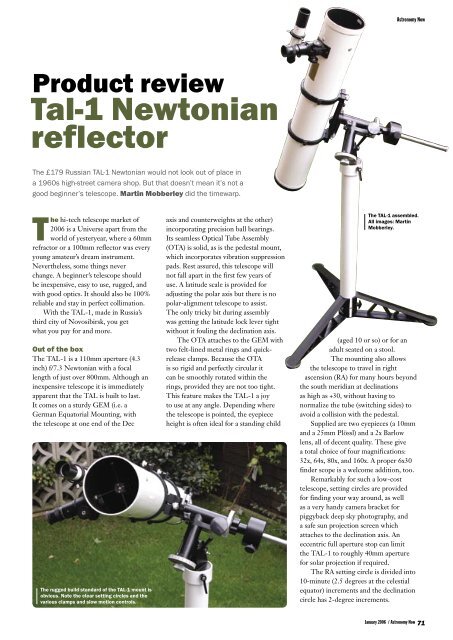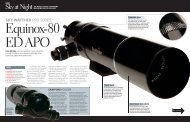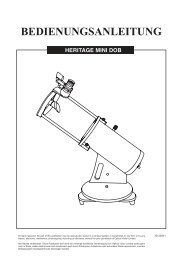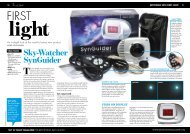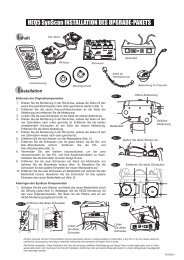Astronomy Now magazine review for TAL-1 - Optical Vision Ltd
Astronomy Now magazine review for TAL-1 - Optical Vision Ltd
Astronomy Now magazine review for TAL-1 - Optical Vision Ltd
Create successful ePaper yourself
Turn your PDF publications into a flip-book with our unique Google optimized e-Paper software.
<strong>Astronomy</strong> <strong>Now</strong><br />
Product <strong>review</strong><br />
Tal-1 Newtonian<br />
reflector<br />
The £179 Russian <strong>TAL</strong>-1 Newtonian would not look out of place in<br />
a 1960s high-street camera shop. But that doesn’t mean it’s not a<br />
good beginner’s telescope. Martin Mobberley did the timewarp.<br />
The hi-tech telescope market of<br />
2006 is a Universe apart from the<br />
world of yesteryear, where a 60mm<br />
refractor or a 100mm reflector was every<br />
young amateur’s dream instrument.<br />
Nevertheless, some things never<br />
change. A beginner’s telescope should<br />
be inexpensive, easy to use, rugged, and<br />
with good optics. It should also be 100%<br />
reliable and stay in perfect collimation.<br />
With the <strong>TAL</strong>-1, made in Russia’s<br />
third city of Novosibirsk, you get<br />
what you pay <strong>for</strong> and more.<br />
Out of the box<br />
The <strong>TAL</strong>-1 is a 110mm aperture (4.3<br />
inch) f/7.3 Newtonian with a focal<br />
length of just over 800mm. Although an<br />
inexpensive telescope it is immediately<br />
apparent that the <strong>TAL</strong> is built to last.<br />
It comes on a sturdy GEM (i.e. a<br />
German Equatorial Mounting, with<br />
the telescope at one end of the Dec<br />
The rugged build standard of the <strong>TAL</strong>-1 mount is<br />
obvious. Note the clear setting circles and the<br />
various clamps and slow motion controls.<br />
axis and counterweights at the other)<br />
incorporating precision ball bearings.<br />
Its seamless <strong>Optical</strong> Tube Assembly<br />
(OTA) is solid, as is the pedestal mount,<br />
which incorporates vibration suppression<br />
pads. Rest assured, this telescope will<br />
not fall apart in the first few years of<br />
use. A latitude scale is provided <strong>for</strong><br />
adjusting the polar axis but there is no<br />
polar-alignment telescope to assist.<br />
The only tricky bit during assembly<br />
was getting the latitude lock lever tight<br />
without it fouling the declination axis.<br />
The OTA attaches to the GEM with<br />
two felt-lined metal rings and quickrelease<br />
clamps. Because the OTA<br />
is so rigid and perfectly circular it<br />
can be smoothly rotated within the<br />
rings, provided they are not too tight.<br />
This feature makes the <strong>TAL</strong>-1 a joy<br />
to use at any angle. Depending where<br />
the telescope is pointed, the eyepiece<br />
height is often ideal <strong>for</strong> a standing child<br />
The <strong>TAL</strong>-1 assembled.<br />
All images: Martin<br />
Mobberley.<br />
(aged 10 or so) or <strong>for</strong> an<br />
adult seated on a stool.<br />
The mounting also allows<br />
the telescope to travel in right<br />
ascension (RA) <strong>for</strong> many hours beyond<br />
the south meridian at declinations<br />
as high as +30, without having to<br />
normalize the tube (switching sides) to<br />
avoid a collision with the pedestal.<br />
Supplied are two eyepieces (a 10mm<br />
and a 25mm Plössl) and a 2x Barlow<br />
lens, all of decent quality. These give<br />
a total choice of four magnifications:<br />
32x, 64x, 80x, and 160x. A proper 6x30<br />
finder scope is a welcome addition, too.<br />
Remarkably <strong>for</strong> such a low-cost<br />
telescope, setting circles are provided<br />
<strong>for</strong> finding your way around, as well<br />
as a very handy camera bracket <strong>for</strong><br />
piggyback deep sky photography, and<br />
a safe sun projection screen which<br />
attaches to the declination axis. An<br />
eccentric full aperture stop can limit<br />
the <strong>TAL</strong>-1 to roughly 40mm aperture<br />
<strong>for</strong> solar projection if required.<br />
The RA setting circle is divided into<br />
10-minute (2.5 degrees at the celestial<br />
equator) increments and the declination<br />
circle has 2-degree increments.<br />
January 2006 / <strong>Astronomy</strong> <strong>Now</strong> 71
<strong>Astronomy</strong> <strong>Now</strong><br />
Collimating<br />
For the first time buyer, how easily a<br />
telescope can be collimated, and whether<br />
it stays in collimation, should be one of<br />
the most fundamental considerations.<br />
Any un-collimated telescope will fail<br />
to per<strong>for</strong>m at high magnification. The<br />
cells supporting the <strong>TAL</strong>’s primary<br />
and secondary mirrors allow easy<br />
collimation of the optics, which will<br />
not slip during normal transportation.<br />
For any Newtonian with an f-ratio<br />
equal or slower than about f/6 (e.g. f/6,<br />
f/7 or f/8+) collimation adjustments<br />
are achievable in daylight without<br />
necessarily having to resort to night-time<br />
star collimation. Even so, a star test is<br />
highly advisable (see Tech talk October<br />
2005). At f/7.3 the <strong>TAL</strong>-1 has a large<br />
collimation sweet spot almost 9mm in<br />
diameter. So little knocks will not put<br />
it out. At a focal length of 800mm the<br />
sweet spot diameter corresponds to 0.6<br />
degrees on the sky, i.e. a razor sharp<br />
image bigger than the Full Moon.<br />
At the eyepiece.<br />
Under the stars<br />
pattern <strong>for</strong> an instrument with a thin 4-<br />
The first thing I appreciated in the dark vane spider and the intra and extra focal<br />
is that the <strong>TAL</strong>-1 has some nice, dualaxis,<br />
slow-motion control wheels, easily good quality mirror. Being such a small<br />
detail was almost identical, indicating a<br />
within arm’s reach, and the RA wheel chunk of glass the mirror adjusted to the<br />
can easily be used to track objects as they air temperature in less than 20 minutes,<br />
drift across the night sky. Both knurled even though the tube is sealed at the<br />
wheels allow roughly ±4 degrees of mirror end to prevent dust settling on<br />
telescope movement, so with the manual the mirror (an open ended design would<br />
RA control you could track an object <strong>for</strong> be better from a thermal viewpoint but<br />
half an hour if required, allowing you, would let the mirror become dirty).<br />
with care, to take a few piggyback wideangle<br />
photographs of constellations. was at its maximum 2005 diameter<br />
When the telescope arrived Mars<br />
Being only 110mm in aperture, the (20 arcseconds) and much detail was<br />
quality of the telescope’s optics was easy visible on the planet’s surface at 160x.<br />
to test. Stars showed<br />
Saturn was a splendid sight too, with<br />
a perfect diffraction<br />
the rings’ Cassini division clearly visible.<br />
The <strong>TAL</strong>-1’s tube,<br />
focuser and finder<br />
are built to last.<br />
72 <strong>Astronomy</strong> <strong>Now</strong> / January 2006<br />
Always a beautiful sight, the double<br />
star Albireo, against the Milky Way<br />
backdrop, did not disappoint at 32x.<br />
Conclusions<br />
It is hard to fault any telescope that<br />
gives you pleasing views, setting circles,<br />
a proper finder, a host of accessories,<br />
and an equatorial mounting <strong>for</strong> £179<br />
and I am really struggling to think<br />
of anything negative to say about<br />
this budget telescope. All in all, the<br />
<strong>TAL</strong>-1 is a friendly, solidly built<br />
winner and reminds me of the Russian<br />
Soyuz spacecraft: 1960s technology<br />
that just keeps on working.<br />
Martin Mobberley has been a member of<br />
the British Astronomical Association <strong>for</strong><br />
over 36 years, serving as President from<br />
1997-1999. His third Springer <strong>Astronomy</strong><br />
book, Lunar & Planetary Webcam<br />
User’s Guide is due out in March.<br />
At a glance<br />
Product:<br />
<strong>TAL</strong>-1<br />
Newtonian Reflector<br />
Supplier: <strong>Optical</strong> <strong>Vision</strong> Limited<br />
Unit 2b, Woolpit Business Park,<br />
Woolpit,<br />
Bury St. Edmunds,<br />
Suffolk IP30 9UP<br />
Web:<br />
www.opticalvision.co.uk<br />
Tel: 01359 244200<br />
Price: £179


